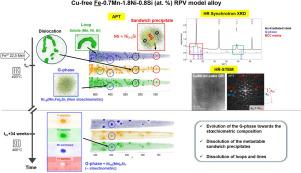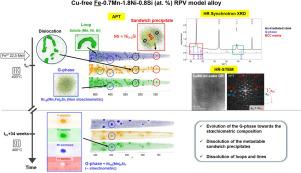Mechanisms of radiation-induced G-phase precipitation in Fe-MnNiSi ferritic model alloys at 400 °C
IF 9.3
1区 材料科学
Q1 MATERIALS SCIENCE, MULTIDISCIPLINARY
引用次数: 0
Abstract
A high-purity model reactor pressure vessel alloy was irradiated with 22.5 MeV Fe9+ ions at 400 °C, producing a radiation dose of 1–2 dpa at a depth of , following by annealing at the same temperature for up to 34 weeks. Irradiation led to the formation of four Mn-Ni-Si-enriched features: spherical precipitates in the bulk and on dislocation lines, sandwich-like precipitates, and toroidal segregation on dislocation loops. High-resolution transmission electron microscopy and synchrotron X-ray diffraction identified bulk precipitates as G-phase, exhibiting L2 symmetry, a cube-on-cube orientation with the matrix, and semi-coherent interfaces. Atom probe tomography showed that the bulk G-phase precipitates have the formula , with increased Fe substitution in the Mn sublattice under irradiation. G-phase precipitates exhibited thermodynamic stability during post-irradiation annealing, while sandwich-like phases dissolved, indicating metastability. Irradiation reduces the matrix solubility limit, which is evidenced by the reduced volume fraction of G-phase precipitates observed in post-irradiation annealed samples. Heterogeneous precipitation of the G-phase on dislocation lines likely occurs through radiation-induced segregation (RIS) of Ni, Si, and Mn. Bulk sandwich-like precipitates with a dense Ni-Si-enriched phase in the center are strongly evidenced to form through a two-step mechanism: the SIAs clustering into a dense NiSi phase, followed by the kinetics of vacancy-solute clustering, leading to the precipitation of the less dense G-phase.


400℃下Fe-MnNiSi铁素体模型合金辐射诱导g相析出机理
采用22.5 MeV Fe9+离子在400℃下辐照高纯度Fe-0.7Mn-1.8Ni-0.8SiFe-0.7Mn-1.8Ni-0.8Si模型反应堆压力容器合金,辐照深度为1μm1μm,辐照剂量为1-2 dpa,在相同温度下退火34周。辐照形成了四种富集mn - ni - si的特征:块体和位错线上的球形沉淀、三明治状沉淀和位错环上的环形偏析。高分辨率透射电子显微镜和同步加速器x射线衍射鉴定出大块析出物为g相,表现出L211对称,与基体呈立方体对立方体取向,以及半相干界面。原子探针层析成像结果表明,g相的析出相为Ni16MnxFe1−x6Si7Ni16MnxFe1−x6Si7,辐照下Mn亚晶格中Fe取代量增加。在辐照后退火过程中,g相析出物表现出热力学稳定性,而三明治相析出物则表现出亚稳态。辐照降低了基体的溶解度极限,辐照后退火样品中g相析出物的体积分数降低。位错线上g相的非均匀析出可能是通过Ni、Si和Mn的辐射诱导偏析(RIS)发生的。大块的三明治状析出物中心有致密的ni - si富集相,其形成机制有两个步骤:SIAs聚集成致密的NiSi相,然后是空位-溶质聚集动力学,导致较不致密的g相的析出。
本文章由计算机程序翻译,如有差异,请以英文原文为准。
求助全文
约1分钟内获得全文
求助全文
来源期刊

Acta Materialia
工程技术-材料科学:综合
CiteScore
16.10
自引率
8.50%
发文量
801
审稿时长
53 days
期刊介绍:
Acta Materialia serves as a platform for publishing full-length, original papers and commissioned overviews that contribute to a profound understanding of the correlation between the processing, structure, and properties of inorganic materials. The journal seeks papers with high impact potential or those that significantly propel the field forward. The scope includes the atomic and molecular arrangements, chemical and electronic structures, and microstructure of materials, focusing on their mechanical or functional behavior across all length scales, including nanostructures.
 求助内容:
求助内容: 应助结果提醒方式:
应助结果提醒方式:


